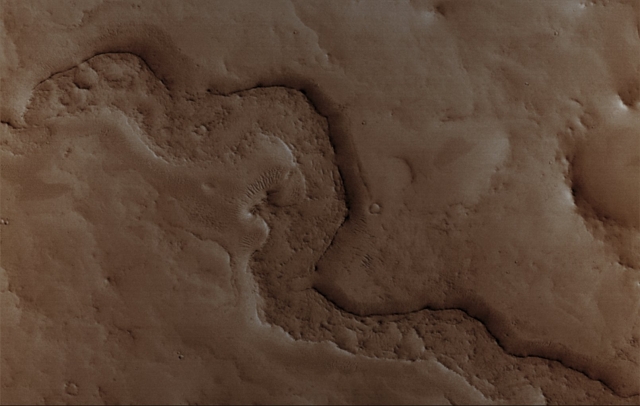
May 18, 2012
Credits: NASA/JPL/Malin Space Science Systems (MSSS) - Credits for the additional process. and color.: Dr Paolo C. Fienga/Lunar Explorer Italia/IPF
|
Arabia Terra is a large Upland Region, densely cratered and heavily eroded, which is located in the Northern Hemisphere of Mars (mostly in the so-called Arabian Quadrangle). This battered topography indicates great age, and Arabia Terra is presumed to be, in fact, one of the oldest terrains of the Red Planet. It covers as much as 4500 Km at its longest extent, and it is centered roughly at 19° 79' North Lat. and 30° 00' East Long., with its Eastern and Southern Regions rising higher than (approx.) 4 Km as to the North/Western ones. Arabia Terra contains many interesting Surface Features and, for instance, there are some good examples of so-called Pedestal Craters in the area. Quite a lot of Mounds and Buttes can be seen on the Floor of many Unnamed Impact Craters and all these Surface Features (such as the Mounds and Buttes, which are basically small and flat-topped Hills) show the existence of Layers. The cause, for these Layers, is still unknown, but we do know that Layering can be caused, among other things, by Volcanic and/or Aeolian Processes as well as by the occurrence of a phenomenon of Underwater Deposition of Materials (i.e.: sediments). Talking about other interesting Surface Features, we have to notice that Dark Slope Streaks have been observed inside Tikhonravov Basin, a large and widely eroded Impact Crater located, of course, in the Arabian Quadrangle. These (sometime even multicolored) Streaks usually appear on steep Slopes and (let's say often, but NOT always!) they can change their shape, texture and color over time. At first (such as when they are recent/just formed) they appear like Dark Striations (mostly dark brown and black); then, in time, they may turn to a lighter (i.e.: light brown-yellow /orange) color, probably because of the deposition, all over them, of fine, light orange-colored Dust that falls, like rain, from the lower strata of the Martian Atmosphere. These Streaks, like some Planetary Scientists say, may also form because of Dust that rapidly moves Downslope (just like Snow Avalanches do on Earth) because of the occurrence, for instance, of slight to moderate vibrations of the Surface (perhaps due to Residual Seismic Activity or to the occurrence of a - relatively close - Meteor Impact) as well as to the verification of a phenomenon known as Gravity Wasting. Last, but not least, the occurrence of a powerful Aeolian Action, as the cause of a Dust Avalanche that, afterwards, ends up by forming the Slope Streaks, cannot be axcluded. Arabia Terra was so officially named after a corresponding Albedo Feature seen on a map of Mars made by the Italian Astronomer Giovanni Schiaparelli (who named this Region after the Earthly Arabian Peninsula). A deeper research about Arabia Terra was undertaken in the AD 1997 and one of its early steps was made by better defining the individuality of the whole Arabian Province as to the other surroundings Regions. In this NASA - Mars Global Surveyor - Mars Orbiter Camera image we can see a somewhat sinuous, nearly flat-topped Ridge, located in Eastern Arabia Terra. The Ridgetop was once the Floor of a Valley, perhaps carved by running water. The Valley Floor, or the Material that covered the Floor, was more resistant to erosion than the surrounding rock into which the Valley was cut. Thus, over time, the Valley disappeared, and its Floor was left standing high as a Ridge. Inverted Valleys are common on Mars, but they can also be found on Earth. Location near: 10,8° North Lat. and 313,2° West Long. This frame has been colorized in Absolute Natural Colors (such as the colors that a human eye would actually perceive if someone were onboard the NASA - Mars Global Surveyor Orbiter and then looked down towards the Surface of Mars), by using an original technique created - and, in time, dramatically improved - by the Lunar Explorer Italia Team.
|
News visualized: 725 times

